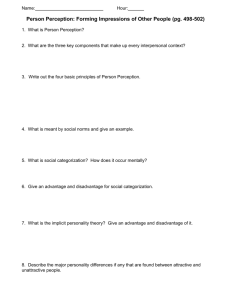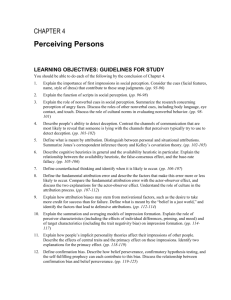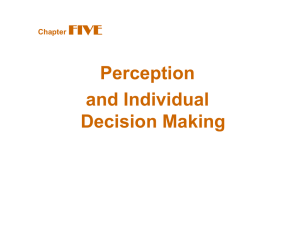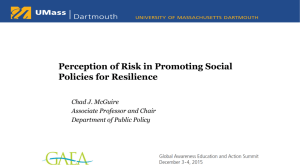Perception and Individual Decision Making
advertisement
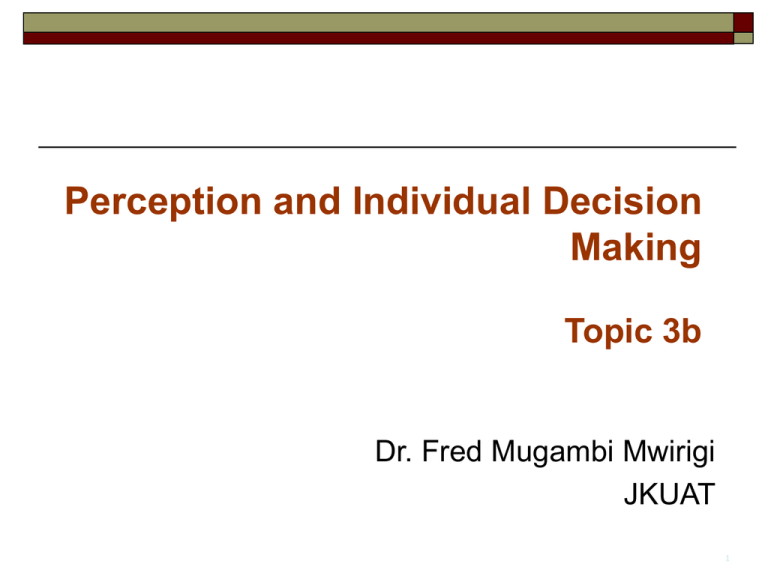
Perception and Individual Decision Making Topic 3b Dr. Fred Mugambi Mwirigi JKUAT 1 Perception and Its Importance Perception A process by which individuals organise and interpret their sensory impressions in order to give meaning to their environment. People’s behaviour is based on their perception of what reality is, not on reality itself. The world as it is perceived is the world that is behaviourally important. Tuesday, March 22, 2016 compiled by Dr. Fred Mugambi 2 Factors that Influence Perception Tuesday, March 22, 2016 compiled by Dr. Fred Mugambi 3 Attribution Theory Our perceptions of people differ from our perceptions of inanimate objects. Attribution theory suggests that when we observe an individual’s behaviour, we attempt to determine whether it was internally or externally caused. That determination depends largely on three factors: Distinctiveness Consensus Consistency Attribution Theory Contd. Distinctiveness refers to whether an individual displays different behaviours in different situations. What we want to know is whether the observed behaviour is unusual. Consensus occurs if everyone who is faced with a similar situation responds in the same way. For example, if consensus is high, you would be expected to give an external attribution to an employee’s lateness at work, whereas if other employees who took the same route made it to work on time, your conclusion as that causation would be internal. Consistency in a person’s actions. Does the person respond the same way over time? The more consistent the behaviour, the more the observer is inclined to attribute it to internal causes. Attribution Theory Contd. Tuesday, March 22, 2016 compiled by Dr. Fred Mugambi 6 Key Errors and Biases in Attributions Fundamental Attribution Error The tendency to underestimate the influence of external factors and overestimate the influence of internal factors when making judgments about the behaviour of others Self-Serving Bias The tendency for individuals to attribute their own successes to internal factors while putting the blame for failures on external factors Tuesday, March 22, 2016 compiled by Dr. Fred Mugambi 7 Frequently Used Shortcuts in Judging Others Selective Perception People selectively interpret what they see on the basis of their interests, background, experience, and attitudes. Halo Effect Drawing a general impression about an individual on the basis of a single characteristic Contrast Effects Evaluation of a person’s characteristics based on comparisons with other people recently encountered who rank higher or lower on the same characteristics Tuesday, March 22, 2016 compiled by Dr. Fred Mugambi 8 Frequently Used Shortcuts in Judging Others Contd. Projection Attributing one’s own characteristics to other people Stereotyping Judging someone on the basis of one’s perception of the group to which that person belongs Tuesday, March 22, 2016 compiled by Dr. Fred Mugambi 9 Specific Applications in Organisations Employment Interview: Perceptual biases of raters affect the accuracy of interviewers’ judgments of applicants Performance Expectations: Self-fulfilling prophecy (Pygmalion effect): The lower or higher performance of employees reflects preconceived leader expectations about employee capabilities. Ethnic Profiling: A form of stereotyping in which a group of individuals is singled out—typically on the basis of race or ethnicity—for intensive inquiry, scrutinising, or investigation Performance Evaluations: Appraisals are often the subjective (judgmental) perceptions of appraisers of another employee’s job performance Tuesday, March 22, 2016 compiled by Dr. Fred Mugambi 10 The Link Between Perception and Individual decision Making Problem A perceived discrepancy between the current state of affairs and a desired state Perception of the Decision Maker Decisions Choices made from among alternatives developed from data perceived as relevant Outcomes Assumptions of the Rational Decision Making Model Rational decision-making model Describes how individuals should behave in order to maximise some outcome Model Assumptions: Problem clarity Known options Clear preferences Constant preferences No time or cost constraints Maximum payoff Steps in Rational decision Making Define the problem Identify the decision criteria Allocate weights to the criteria Develop the alternatives Evaluate the alternatives Select the best alternative. How are Decisions Actually Made in Organizations? Bounded Rationality Individuals make decisions by constructing simplified models that extract the essential features from problems without capturing all their complexity. Common Biases and Errors Overconfidence Bias Anchoring Bias Confirmation Bias Availability Bias Winner’s Curse Randomness Error Hindsight Bias Intuition Intuitive Decision-Making An unconscious process created out of distilled experience Conditions Favouring Intuitive Decision Making: A high level of uncertainty Little precedent to draw on Less scientifically predictable Variables Limited facts Facts that don’t clearly point the way forward Analytical data of little use Existence of several plausible alternative solutions exist Time limitation Ethics in decision Making Ethical Decision Criteria Utilitarianism Seeking the greatest good for the greatest number Rights Respecting and protecting basic rights of individuals such as whistleblowers Justice Imposing and enforcing rules fairly and impartially Ways to Improve Decision Making Analyse the situation and adjust your decisionmaking style to fit the situation. Be aware of biases and try to limit their impact. Combine rational analysis with intuition to increase decision-making effectiveness. Don’t assume that your specific decision style is appropriate to every situation. Enhance personal creativity by looking for novel solutions or seeing problems in new ways, and using analogies. Reducing Biases and Errors Focus on goals Clear goals make decision making easier and help to eliminate options inconsistent with your interests. Look for information Overtly considering ways we could be that disconfirms wrong challenges our tendencies to beliefs think we’re smarter than we actually are. Don’t try to create meaning out of random events. Don’t attempt to create meaning out of coincidence. Increase your options The number and diversity of alternatives generated will increase the chance of finding an outstanding one. End of Topic Three
